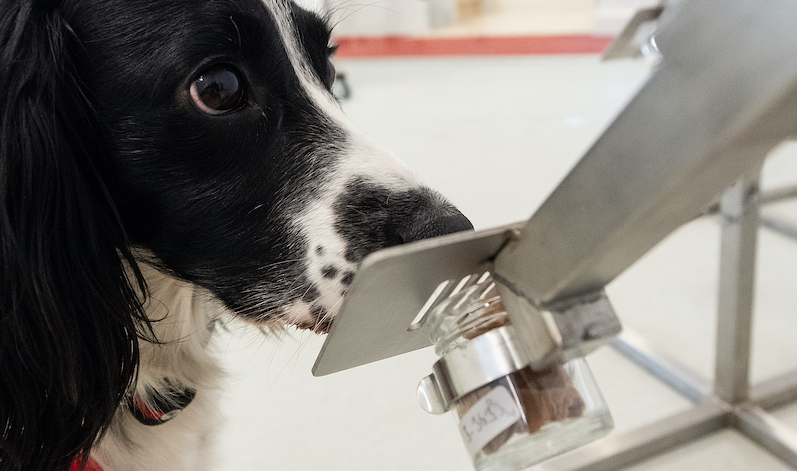
Scholars propose to modify the current regulatory regime for animal-based medical diagnostics.
Researchers taught a beagle named Cliff to sniff for a common hospital bacteria in 2012. The dog proved faster, more accurate, and less invasive than FDA-approved tests. Since then, dogs became a promising resource in medical diagnostics and have been trained to detect the early stages of cancer and, most recently, COVID-19.
But how should the U.S. Food and Drug Administration (FDA) regulate animals as diagnostic devices?
Although FDA does not usually regulate animals for medical uses and has never regulated animals as diagnostic devices, Matthew Avery and Makenzi Galvan of the University of California Hastings College of Law predict that FDA will try to regulate animal-based medical diagnostics. But they argue that the agency’s current regulatory scheme does not adequately address the unique safety and efficacy issues posed by animal-based medical diagnostics. Instead, Avery and Galvan propose a modified regulatory regime to address the distinctive issues raised by animal-based diagnostics.
Animals that perform diagnostic functions are analogous to conventional diagnostic tests, Avery and Galvan argue. They assert that this is because animals used “in the diagnosis of disease or other conditions” fall under the definition of a medical device in the Food, Drug, and Cosmetic Act and are thus subject to FDA regulatory authority.
The current diagnostic testing framework divides tests into two categories: in vitro diagnostic (IVD) assays, and laboratory-based tests (LDT). and Avery and Galvan note that which category applies to a particular type of test depends on whether the test was “designed and manufactured completely or partially outside of the laboratory that offers and uses them.” IVDs and LTDs are regulated differently. FDA has historically opted to regulate only IVDs and delegate their regulatory authority over LDTs to the Centers for Medicare and Medicaid Services (CMS.)
If FDA regulates animal-based medical diagnostics as IVDs by deeming them analogous to an individually marketed test kit, Avery and Galvan anticipate that animal-based diagnostics will be defined as Class III devices, the most regulated category. They explain that this scrutiny will be a result of increased safety concerns and potential for variance in diagnostic results that animals pose over conventional devices because of a variety of factors, such as varied attention spans and olfactory capabilities.
Class III devices require “valid scientific evidence” to attest to the clinical validity of the diagnostic, Avery and Galvan explain. They argue that developing feasible strategies to obtain evidence when researchers cannot currently pinpoint which factors contribute to variation between animal-based diagnostic results will make meeting this standard difficult.
On the other hand, animal-based medical diagnostics can be treated as LDTs with the dogs performing their services under controlled laboratory conditions. This pathway is subject to oversight by CMS and would only require evidence of analytical validity, Avery and Galvan claim. Because of the laboratory-based nature of LDTs, Avery and Galvan argue that laboratory-based testing can be designed to account for the factors that may contribute to inherent animal-based variance.
If animal-based medical diagnostics are treated as equivalent to an IVD or LDT, they will be required to show either that “the device has the same technological characteristics as the predicate” or that the technological differences do not result in differences of safety and efficacy. Because animal-based medical diagnostics do not use the same technological characteristics as conventional diagnostics, Avery and Galvan argue that they must be shown to be clinically and analytically equivalent to conventional diagnostics.
Avery and Galvan claim that the LTD approval pathway presents the largest challenge because animal olfactory processes are still rather unknown. A conventional test may detect bacteria through gene amplification, while a dog relies on its olfactory receptors that detect components that researchers cannot fully identify or understand, Avery and Galvan explain. Without modification, animal-based medical diagnostics may be barred from using the LTD pathway because of the need to prove currently undiscovered mechanisms, Avery and Galvan argue.
To clarify and provide a better path for regulating animal-based diagnostics, FDA must issue documentation to guide the evidentiary requirements necessary for regulatory approval, Avery and Galvan claim. They contend that FDA must directly address the standard for demonstrating the clinical and analytical validity of animal-based medical diagnostics in light of inherent animal-related variance. Avery and Galvan also argue that FDA must establish a standardized review process that allows animal-based medical diagnostics to be reproduced successfully, including standards for the specific training and testing of animals for diagnostic use.
Avery and Galvan outline three propositions for FDA when considering a regulatory pathway for animal-based diagnostics.
First, they call for FDA to standardize the training methods of diagnostic animals to ensure consistent and accurate results. Pointing to published guidelines for the training of dogs in other contexts, such as the detection of drugs, explosives and viruses, Avery and Galvan explain that FDA could use these as a basis for developing their own guidelines or choose to adopt them directly.
Second, FDA should appoint validity and quality assurance measures. They explain that this proposition is based on current research that suggests that “animals require continuous retraining to maintain their detection abilities.”
Third, Avery and Galvan call for FDA guidance for developing and implementing these procedures to assure long-term efficacy and safety standards.
Ultimately, Avery and Galvan argue that FDA must clarify how to demonstrate the clinical and analytical validity of diagnostic animals. For example, FDA should explain whether the “same technological characteristic” component requires using the same animal breed and whether differences in training would raise questions related to the safety and effectiveness requirement.
Given pandemic fears and the increased need for rapid, non-invasive testing, regulating the powerful sniffs of dogs like Cliff can provide the much-needed solution.



